Understanding the Fundamentals of Body Preservation
Embalming of body is the art and science of preserving human remains by treating them with chemicals to delay decomposition, improve appearance, and ensure sanitation. This process serves three primary goals:
- Sanitization - Disinfecting the body to prevent disease transmission
- Preservation - Slowing natural decomposition for viewing and services
- Presentation - Restoring a peaceful, lifelike appearance for families
The practice dates back over 7,000 years to ancient civilizations, but modern embalming emerged during the American Civil War when formaldehyde-based solutions revolutionized body preservation. Today's embalming typically takes 2-4 hours and involves arterial injection of preservative fluids, cavity treatment, and cosmetic restoration.
While embalming is not legally required in most U.S. states, it remains common for open-casket viewings, delayed services, or when transporting remains across state lines. Modern embalming fluid contains 5-35% formaldehyde along with other chemicals like methanol, glutaraldehyde, and dyes.
I'm Mortuary Cooler, a national-level mortuary cooler supplier with experience in embalming of body preservation equipment and the technical requirements of modern funeral homes. My background includes supplying reliable, American-made mortuary equipment that supports the critical temperature control needs during the embalming process.
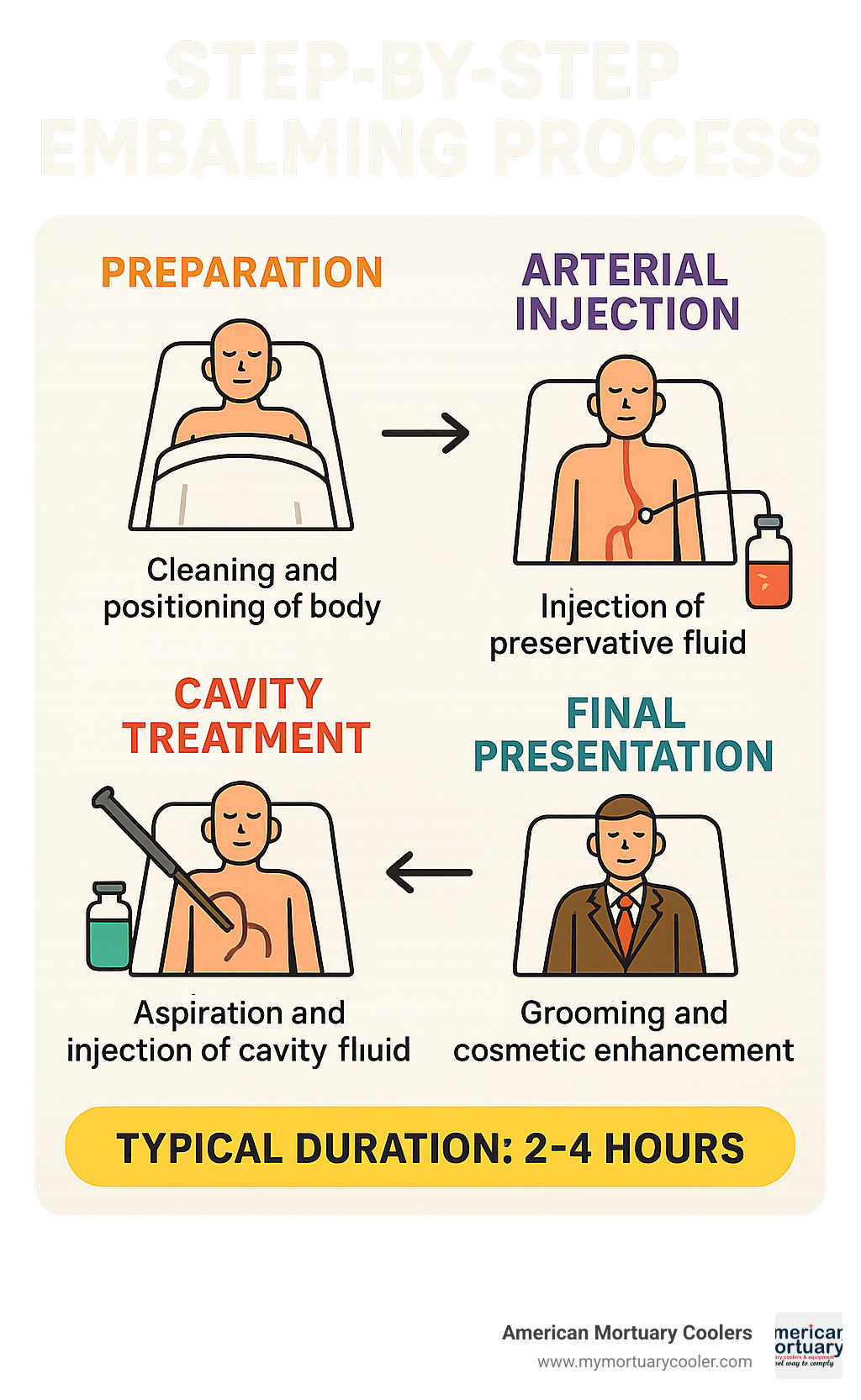
Embalming of body terms explained:
The Science and Art Behind Embalming of Body
When we think about embalming of body, it's a fascinating blend of chemistry, biology, and artistry. The science starts with understanding what happens after death - autolysis begins within minutes as cells break down, while bacteria multiply rapidly without immune system control.
Modern embalming targets the vascular system, using the network of arteries and veins to distribute preservative chemicals throughout the body. The Science of Embalming: Chemistry, Microbiology, and Anatomy in Modern Preservation explains how formaldehyde creates cross-links between proteins, preventing bacterial growth and tissue breakdown.
What is Embalming of Body?
Embalming of body is the process of temporarily preserving human remains using chemical treatments. According to Scientific research on embalming, every procedure focuses on three core goals: Sanitization eliminates harmful bacteria and pathogens, preservation slows decomposition to provide time for families, and presentation ensures loved ones look peaceful and familiar.
Modern mortuary science offers different approaches depending on purpose. Funeral embalming uses gentler chemicals for short-term preservation, while anatomical embalming employs stronger solutions for extended medical study.
Goals of Embalming of Body
The most important goal of embalming of body is buying time for families to make thoughtful decisions while grieving. Public health protection represents another crucial benefit, controlling bacterial growth and preventing disease transmission.
The psychological aspects provide genuine comfort during grieving. Many families describe seeing their loved one looking peaceful as getting one last "good memory" to carry forward. Transportation needs often make embalming practical when moving remains across distances or internationally.
Key Roles: Embalmer vs Mortician vs Funeral Director
An embalmer focuses on technical preservation aspects, completing specialized mortuary science programs to earn licenses. Morticians combine embalming skills with broader funeral service knowledge. Funeral directors primarily coordinate services and support families, though many also hold embalming licenses. Restorative art specialists combine technical knowledge with artistic ability to help trauma victims look more like themselves.
From Mummies to Mortuaries: The Evolution of Embalming
The journey of embalming of body techniques stretches back over 7,000 years. The Chinchorro culture of Chile and Peru started preserving their dead around 5000-6000 BCE, making them the world's first embalmers by over 2,000 years.
Egyptian mummification reached its peak between 1738 and 1102 BCE. According to the Encyclopedia Smithsonian: Egyptian Mummies, approximately 730 million bodies were mummified in Egypt between 400 BC and 700 AD.
The American Civil War transformed embalming from an elite practice into standard funeral service. The findy of formaldehyde in 1855 provided the chemical foundation for modern embalming.
Ancient and Medieval Techniques
Egyptian embalmers mastered natron - a salt mixture that dried tissues and prevented decay. They removed organs through small incisions, storing them in canopic jars, and filled body cavities with myrrh, spices, and perfumed materials.
Other cultures developed creative approaches. Greeks sometimes used honey as a preservative, while Romans focused on cavity treatments. Medieval Europe used cerecloth - wax-soaked fabrics that provided basic, affordable preservation.
Modern Milestones
The Hunter brothers in 18th-century Scotland pioneered injection methods through blood vessels. Early embalmers experimented with arsenic-based fluids before formaldehyde's findy provided safer, more effective preservation.
The Walter Thiel method from the 1960s uses specialized chemicals for anatomical study, showing how embalming continues evolving. For current practices, The Complete Guide to the Embalming Process explores modern methods.
Step-by-Step Modern Embalming Process
The modern embalming of body process typically takes 2-4 hours, combining arterial injection, cavity treatment, hypodermic application, and surface embalming. The A Guide to the Embalming Process Explained breaks down these procedures into manageable steps.
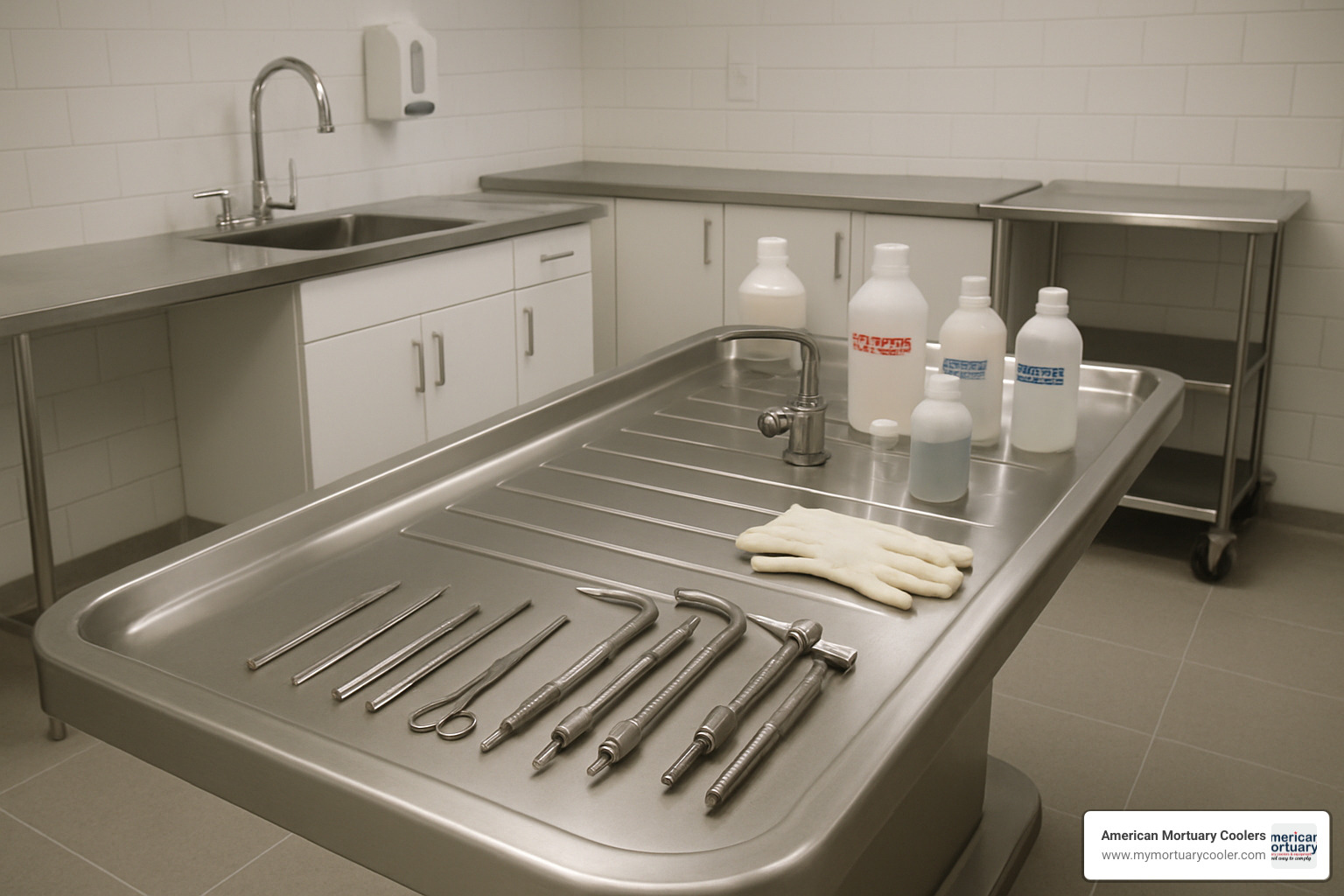
Pre-Embalming Preparation
Every embalming of body procedure starts with identity verification and documentation of personal belongings. Initial disinfection involves thorough washing with germicidal soap while removing clothing and medical devices.
Feature setting requires closing eyes using plastic eye caps and positioning the mouth with wire or suture techniques for natural expressions. Device removal includes pacemakers (which must be removed before cremation) and other medical implants that might interfere with fluid distribution.
Arterial & Cavity Embalming Surgery
Embalmers typically choose the right common carotid artery for injection and internal jugular vein for drainage. Modern Embalming Machines provide precise pressure control at 3-12 psi, circulating 2-3 gallons of diluted formaldehyde solution.
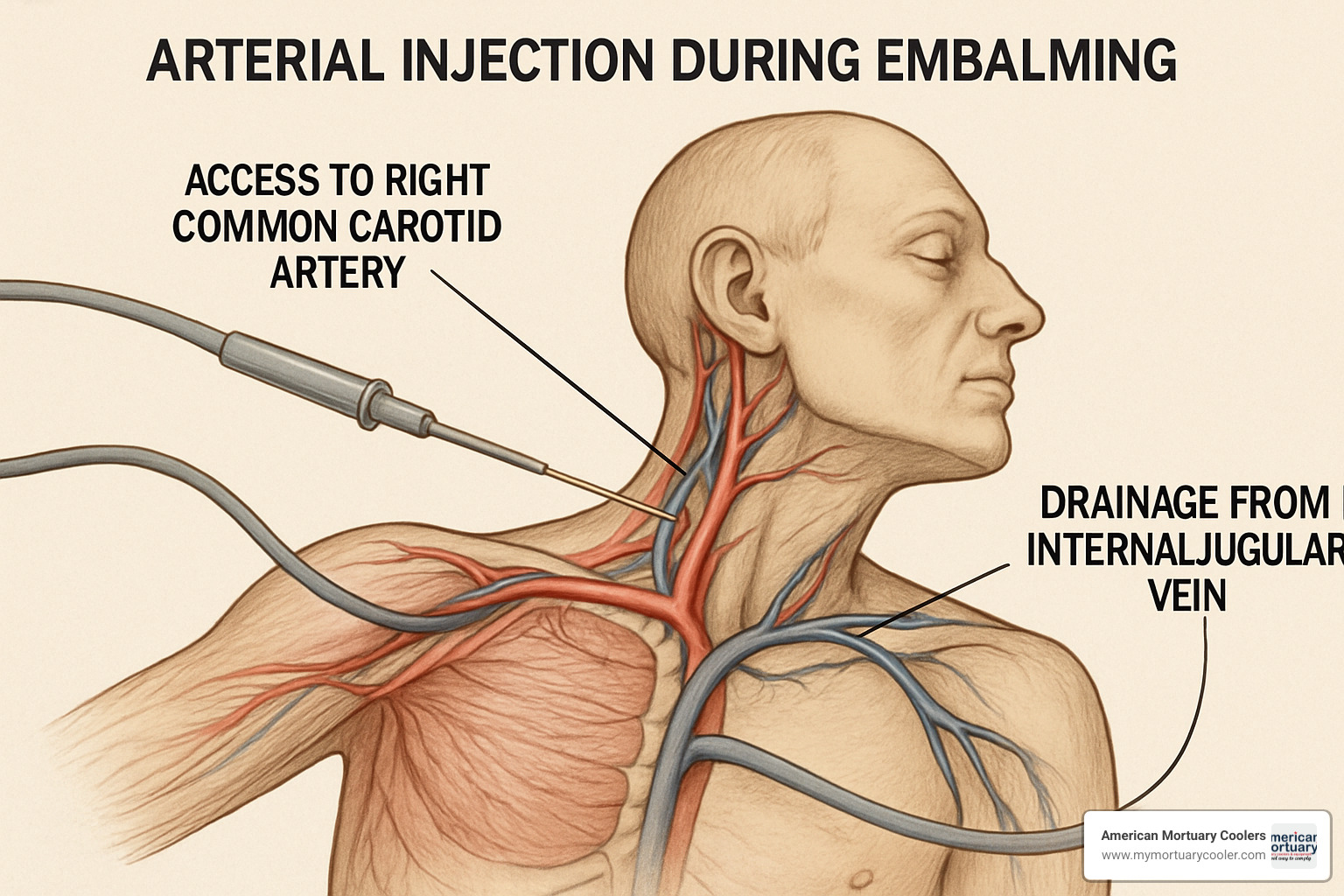
Formaldehyde concentrations range from 5-35%, with methanol content between 9-56%. Cavity embalming uses a trocar to remove gases and fluids from internal organs before injecting stronger cavity fluid.
Cosmetic Restoration & Dressing
The final phase transforms preservation into dignified presentation. Embalmers apply specialized mortuary cosmetics and style hair according to family preferences. Dressing procedures require careful positioning, often using Hydraulic, Stainless Steel, and Cheap Embalming Tables for Every Budget for proper working height.
Special Cases: Autopsy, Trauma, Long-Term, Anatomical Study
Autopsy cases require six-point injection using multiple arterial sites. Trauma cases need extensive restorative work with surface embalming packs. The Step-by-Step Guide to Needle Injector Embalming provides protocols for compromised circulation areas.
Long-term preservation uses high-index fluids with 25-35% formaldehyde concentrations. Plastination replaces body fluids with reactive plastics for permanent, odorless specimens used in medical education.
Chemicals, Equipment, and Environmental Considerations
The chemistry behind embalming of body involves carefully balanced mixtures. Modern embalming fluids contain formaldehyde (5-35%), methanol, glutaraldehyde, and dyes. The Everything You Need to Know About Embalming Supplies details these chemical combinations.
According to Human body preservation – old and new techniques, families now have more preservation choices than ever, each with different environmental impacts.
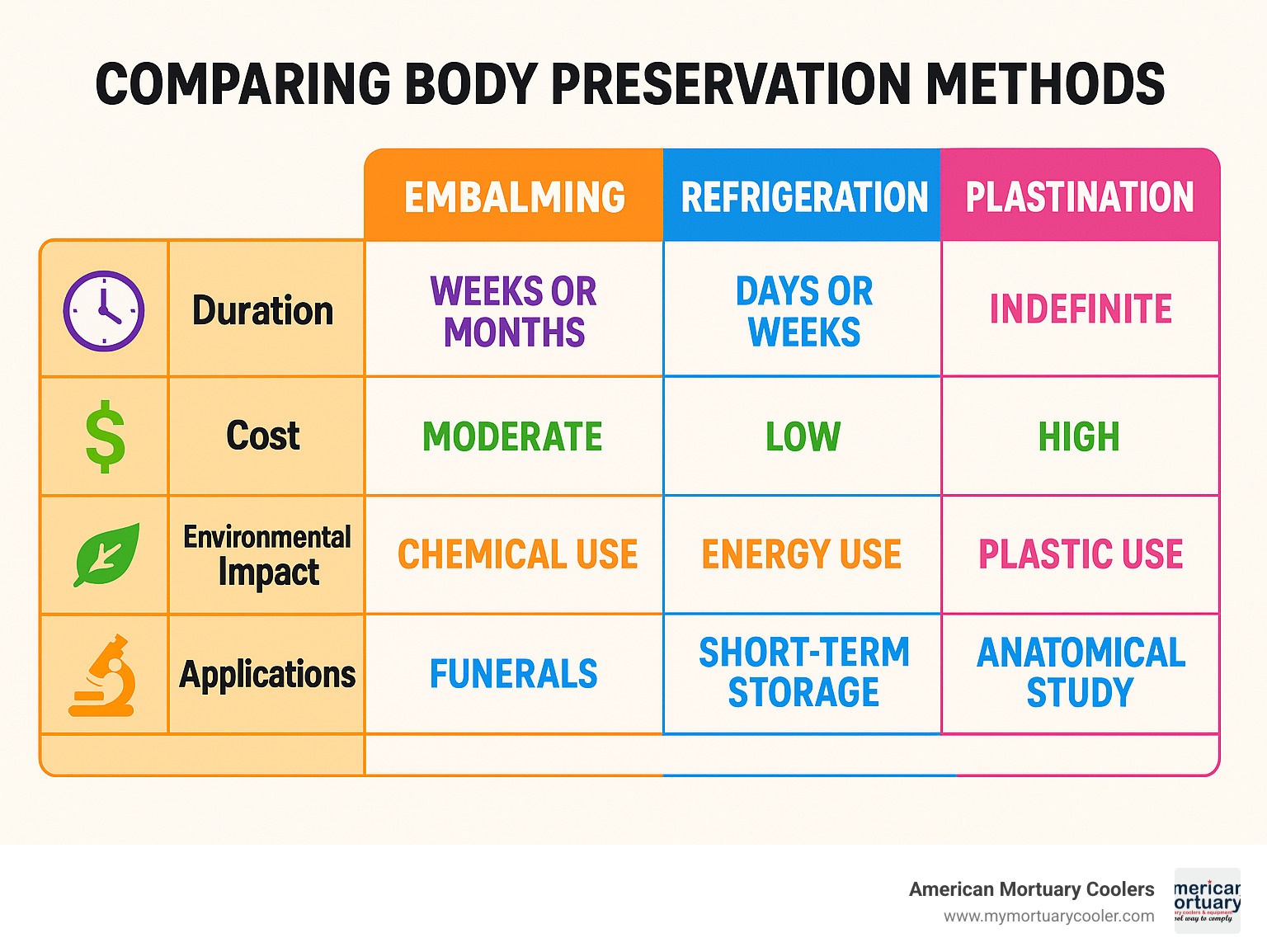
Key Chemical Functions
Preservatives like formaldehyde cross-link proteins, preventing bacterial breakdown. Germicides kill harmful pathogens beyond preservation effects. Surfactants help fluid spread evenly through tissues. Humectants prevent excessive drying, while colorants help embalmers track fluid distribution and add natural-looking color.
Equipment & Safety Protocols
Embalming tables need proper drainage and height adjustment. Embalming machines control pressure between 3-12 psi. Aspirators and trocars handle cavity work efficiently.
Mortuary coolers maintain proper temperature throughout the process - our expertise at American Mortuary Coolers becomes crucial here. Temperature control affects fluid penetration and process duration.
Personal protective equipment includes chemical-resistant gloves, eye protection, and respiratory gear. Negative pressure ventilation protects embalmers from formaldehyde exposure per OSHA requirements.
Eco-Friendly Alternatives
Green burial practices skip embalming, using refrigeration and prompt burial. Refrigeration alone preserves bodies for days or weeks without chemicals. Formaldehyde-free embalming fluids use alternative preservatives like glutaraldehyde.
Alkaline hydrolysis uses heated alkaline solution for "green cremation," producing sterile liquid and clean bone fragments while avoiding traditional cremation emissions.
Laws, Cultures, Religions, and Grief
Decisions about embalming of body treatment involve legal requirements, cultural traditions, and religious beliefs. Embalming is not legally required in most U.S. states, typically mandated only for infectious diseases, delayed services, or interstate transport. The How to Learn Embalming: 5 Methods That Guarantee Results covers regulatory frameworks.
Global Regulations & Repatriation
North American families choose embalming at high rates despite no universal legal requirement. European families rarely use embalming except for transport or special requests. International transport often requires embalming certificates and specific preservation protocols for public health reasons.
Religious Perspectives on Embalming
Catholic doctrine generally permits embalming, viewing preservation as compatible with resurrection beliefs. Orthodox Christian traditions often discourage embalming, preferring prompt burial. Islamic law typically prohibits embalming as unnecessary interference, emphasizing burial within 24 hours. Jewish traditions generally discourage embalming except when legally mandated. Hindu perspectives vary by regional traditions, with cremation being preferred.
Impact on the Grieving Process
Many families find viewing preserved remains provides meaningful closure and positive final memories. The "memory picture" concept suggests final visual impressions significantly influence grief processing. However, healthy grieving can occur with or without embalming, depending on individual family needs and cultural preferences.
Frequently Asked Questions about Embalming of Body
Is Embalming of Body Required by Law?
Embalming of body is not legally required in most U.S. situations. Most states only require preservation for infectious disease cases, extended delays before burial/cremation, or interstate transport. International repatriation almost universally requires embalming for air transport.
How Long Does Embalming Effect Last?
Standard funeral embalming maintains presentation quality for several days to weeks. Duration depends on body condition at death, chemical strength, and environmental conditions like temperature and humidity. Anatomical embalming uses higher concentrations for years-long preservation.
What Are the Costs and Alternatives?
Embalming of body costs typically range from $500-$700. Refrigeration offers budget-friendly short-term preservation. Direct cremation eliminates preservation costs entirely. Green burial practices avoid both embalming and cremation expenses while supporting environmental goals.
Conclusion
Understanding embalming of body options helps families make informed decisions during difficult times. The sanitization, preservation, and presentation goals of modern embalming have evolved from ancient Egyptian techniques to today's precise chemical processes, blending scientific knowledge with artistic restoration.
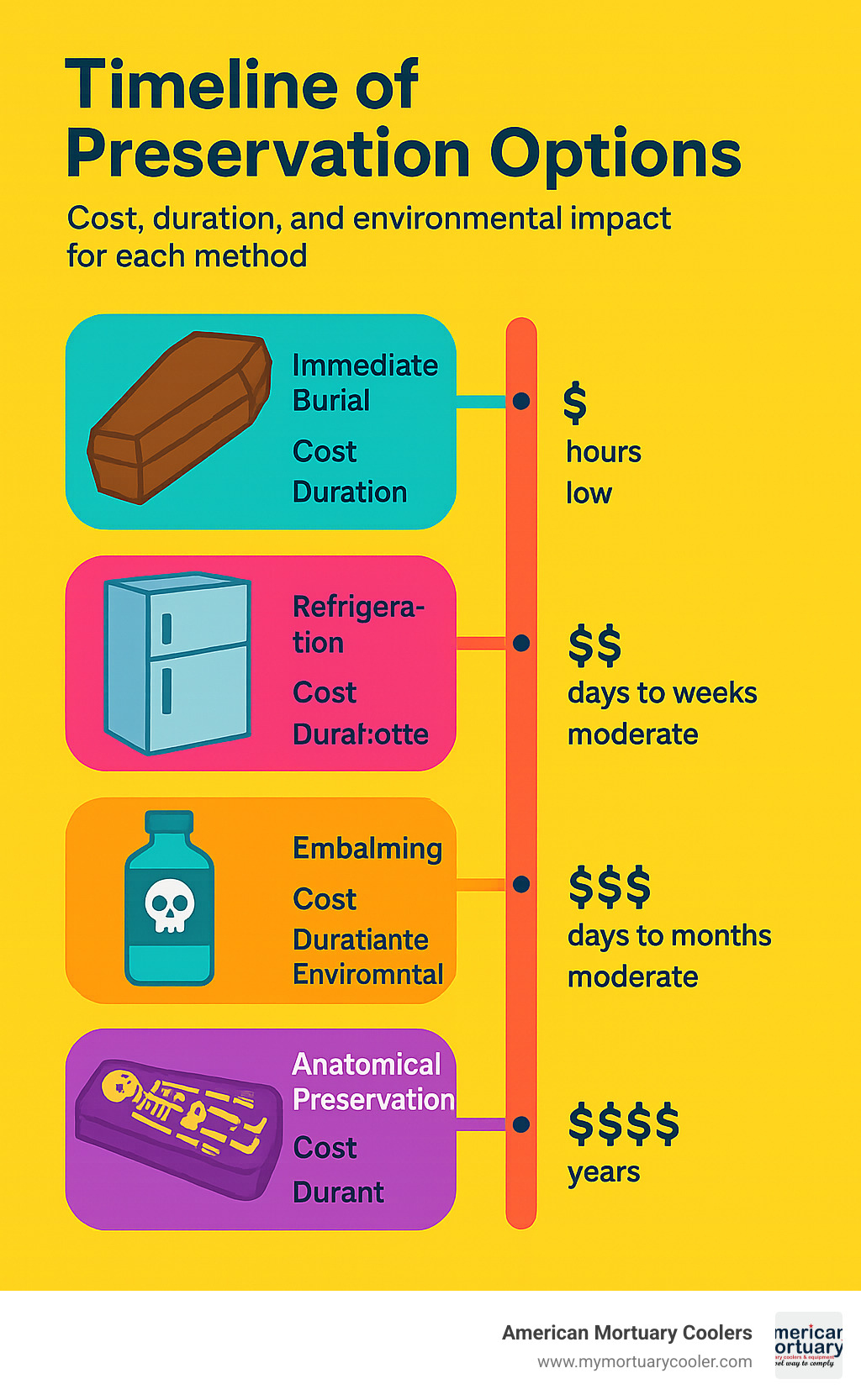
Embalming is rarely legally required - most states only mandate preservation for specific situations like infectious diseases or transport. This gives families genuine choices based on cultural traditions, religious beliefs, and personal preferences.
Growing environmental awareness has opened new pathways including formaldehyde-free fluids, refrigeration, and natural burial options. Families can align their choices with their values while meeting practical needs.
Behind every successful procedure lies quality equipment maintaining proper conditions. At American Mortuary Coolers, we understand how reliable temperature control supports funeral professionals nationwide. From our Tennessee facility, we craft custom mortuary coolers that funeral homes depend on coast to coast.
The decision about embalming of body ultimately belongs to each family. Professional funeral directors can explain options and requirements, but the choice reflects your unique way of honoring your loved one. Some find comfort in traditional viewing services, others prefer simpler approaches - both honor the deceased meaningfully.
For More info about mortuary coolers and how proper temperature control supports funeral service needs, we're here to help funeral professionals provide reliable service during families' most important moments.
















